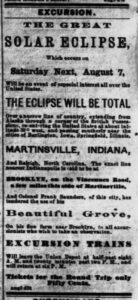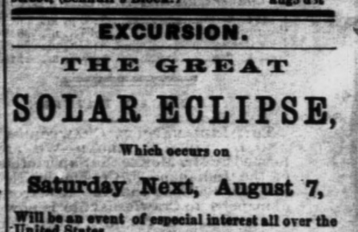By David Heighway, Hamilton County Historian
It’s difficult to miss the activities being planned around the total solar eclipse that will be happening on April 8. Of course, this isn’t the first eclipse to be seen in Hamilton County. There are some interesting accounts that describe how people reacted to earlier ones. The accounts below will look at total eclipses, which are different then annular eclipses. Moreover, most of the local historic events were partial eclipses.
While there are no accounts of the eclipse that passed directly over the area on September 14, 1205, it’s important to remember that it did have witnesses. The indigenous culture at Strawtown was thriving at that point in time. These were Mississippian peoples who had built mound structures and a palisaded village. They were contemporary with the culture that built the city of Cahokia in Illinois. Their response to the eclipse can only be guessed at.

Newspaper article about the solar eclipse in the August 5, 1869 issue of the Daily Sentinel
The first locally recorded total eclipse was on August 7, 1869. It was visible in the southern part of the state, and the nearest good viewing site was at Martinsville. The Peru & Indianapolis Railroad created a special excursion train to transport people from Hamilton County. There is a long, descriptive article in the August 12, 1869 issue of the Noblesville Register about the trip. It describes the excitement from the crowd and the shouts as totality began to happen and the eerie partial light when the sun was obscured. Many people used smoked glass to watch, which is actually very dangerous to do and probably ruined the eyesight of a lot of them. Afterwards, there were problems with overcrowding on the return train due to poor planning, and many people were stranded in Indianapolis when they were late for their connecting trains. Planners for the upcoming event are working hard to avoid situations like this.
The next total eclipse happened on July 29, 1878. This one was observable from Noblesville, with about two-thirds coverage. The Noblesville Ledger was disturbed by how little attention or excitement there was. If some smoked glass was handy, people took a quick glance and went about their business. The Hamilton County Democrat newspaper only made a couple of sarcastic remarks.
By the time of the next eclipse on June 8, 1918, the media had access to better information, and the descriptions of what to expect were more precise. There were even warnings about making sure to stay on Daylight Savings Time so as not to get the time wrong and miss it. Interestingly, even though scientists were using large telescopes and other complex equipment to study the phenomenon, people were still using smoked glass as a way to view it. The path of the eclipse was largely in the western and southern part of the U.S. but was 80% visible in Hamilton County.
The eclipse on January 24, 1925 passed over the northern U.S., including New York City, which meant that it got a lot of coverage in the national news. While it was partially visible in Noblesville, it was regarded as a disappointment. People said that it was not as good as the one in 1918.
There was almost nothing in the local papers for the March 7, 1970 eclipse. It passed over the eastern U.S. and had 77% coverage in central Indiana. It was different for the August 21, 2017 event. It passed over much of the U.S., including southern Indiana, and had 91% coverage in the Indianapolis area. There was much more interest in that.
Now, central Indiana is about to experience full totality for the first time in around 800 years. Read about HEPL’s plans to celebrate the eclipse and keep an eye out for more opportunities to get a pair of eclipse glasses for safe viewing.
